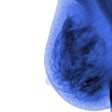Breast imaging is a minefield of potential legal exposure, which is one reason many radiologists shy away from the discipline. But mammography malpractice can be managed by taking a few simple steps, according to breast imaging experts.
The U.S. is one of the most litigious countries in the world, and it's not surprising that it also boasts one of the highest recall rates for breast imaging. In response to the threat of medical malpractice suits from patients, breast imagers have gotten increasingly conservative when it comes to screening and diagnosis.
"The fear of litigation is always in the back of the radiologists' minds," said Dr. Michael Linver, vice president of the National Consortium of Breast Centers (NCBC) and a practicing radiologist at X-Ray Associates of New Mexico in Albuquerque. "Sometimes it dictates the way they perform breast imaging. They're just not willing to take any chances at missing cancer."
Delayed diagnosis leads to lawsuits
Malpractice suits against breast imagers tend to fall into three categories: failure to diagnose, failure to act in a timely fashion, and failure to disclose results to the patient, according to Bonnie Rush, consultant and president of Breast Imaging Specialists (BIS) of San Diego.
"These suits center on the ultimate treatment of the patient, and whether the doctor has put her at greater risk," Rush said.
Of these three, delayed diagnosis is the most common reason legal suits are brought against breast imagers, according to a study presented at the 2008 RSNA meeting in Chicago. Dr. H.N. Purushothaman and colleagues from King's College Hospital, Guy's Hospital, and St. Thomas' Hospital, all in London, examined records from 64 medicolegal investigations that had occurred over the period of January 2004 to December 2007. Thirty percent of the patients represented in the study were younger than 40 years of age.
Delay in diagnosis was the main complaint, at 94%, followed by inappropriate or inadequate treatment. Mean average delay in diagnosis was 17.2 months.
Of the delayed diagnosis cases, 88% were patients who had presented with symptoms; 12% were from patients who were identified through a screening protocol.
The main presenting symptom was a palpable lump (66%), followed by nipple inversion. Substandard care was cited in 47% of the cases, of which 73% were considered to be the fault of the radiologists and 13% were considered the fault of the breast surgeon.
Of the cases in which the radiologist was considered at fault, microcalcifications were the most commonly missed or misinterpreted mammographic signs (12 of 22 cases, or 55%), followed by distortion (six of 22 cases, or 28%).
Calcifications may be the easiest characteristic to see, but they can be the hardest to analyze, Linver said.
"Assessing calcifications is one of the toughest parts of the job," he said. "The differences between benign and malignant are subtle, sometimes indistinguishable. And the kinds of calcifications that sit on the fence between benign and malignant tend to be slow-growing."
Combine this challenge with patients' perception that mammography is infallible, and conditions for lawsuits abound.
"Patients don't realize that at least 20% of breast cancers aren't identified by conventional imaging technologies," Linver said. "They're holding unrealistic expectations for modalities that are not perfect."
Document, document, document
One of the best ways a facility can provide the best patient care and also protect itself and its doctors from lawsuits is by keeping methodical records of patient contacts and thinking carefully about how its staff interacts with those patients, according to Rush.
For instance, a facility should note in a patient's record whether she has received a clinical breast exam (CBE) from her primary care physician before undergoing a screening mammogram. If she hasn't, have her sign a form that states she understands that the CBE may produce other findings, Rush said.
"If the mammogram is negative, but her physician finds something afterward via CBE, she needs to understand that the facility that performed the mammogram can't be held responsible for that," Rush said. "I tell facilities that they should specifically ask the woman whether her doctor found anything in her breast during the CBE. Then when she says, 'I didn't have one,' the technologist can have her sign the paperwork that indicates she understands that mammography isn't the end-all, be-all of cancer screening and diagnosis."
Communicating with the patient clearly is also part of avoiding suits, and Rush recommends four steps: Call to ask the woman to come back in for further tests if necessary; send a follow-up letter that does the same; if the patient doesn't appear for her appointment, send a registered letter that lets her know that the facility has made repeated attempts to inform her of the need to come in for additional imaging or biopsy; and finally, send a letter to her doctor outlining the situation.
"Write any communication as if a lawyer is looking over your shoulder," Rush said.
Good communication during the patient's actual visit also helps. "See her on time, don't overschedule. Make sure the technologist really listens to what she has to say and explains clearly how she will get test results," Rush said. "Patients will be less inclined to sue if they feel their visit went smoothly."
By Kate Madden Yee
AuntMinnie.com staff writer
January 13, 2009
Related Reading
Treatment delays common in men with breast cancer, July 8, 2008
Walking the tightrope: The legal and regulatory impact of digital mammography, October 11, 2007
Minority women still face lag time for breast cancer diagnosis, treatment, December 27, 2006
Frivolous malpractice lawsuits uncommon: study, May 12, 2006
U.K. breast cancer patients wrongly given all-clear, January 24, 2006
Copyright © 2009 AuntMinnie.com




















